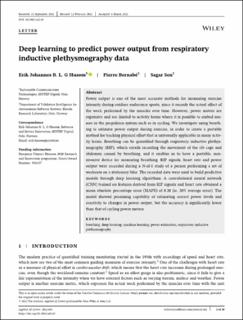| dc.contributor.author | Husom, Erik Johannes | |
| dc.contributor.author | Bernabé, Pierre | |
| dc.contributor.author | Sen, Sagar | |
| dc.date.accessioned | 2022-12-02T12:07:32Z | |
| dc.date.available | 2022-12-02T12:07:32Z | |
| dc.date.created | 2022-04-20T11:16:53Z | |
| dc.date.issued | 2022 | |
| dc.identifier.citation | Applied AI Letters. 2022, 3 (2), e65. | en_US |
| dc.identifier.issn | 2689-5595 | |
| dc.identifier.uri | https://hdl.handle.net/11250/3035615 | |
| dc.description.abstract | Power output is one of the most accurate methods for measuring exercise intensity during outdoor endurance sports, since it records the actual effect of the work performed by the muscles over time. However, power meters are expensive and are limited to activity forms where it is possible to embed sensors in the propulsion system such as in cycling. We investigate using breathing to estimate power output during exercise, in order to create a portable method for tracking physical effort that is universally applicable in many activity forms. Breathing can be quantified through respiratory inductive plethysmography (RIP), which entails recording the movement of the rib cage and abdomen caused by breathing, and it enables us to have a portable, non-invasive device for measuring breathing. RIP signals, heart rate and power output were recorded during a N-of-1 study of a person performing a set of workouts on a stationary bike. The recorded data were used to build predictive models through deep learning algorithms. A convolutional neural network (CNN) trained on features derived from RIP signals and heart rate obtained a mean absolute percentage error (MAPE) of 0.20 (ie, 20% average error). The model showed promising capability of estimating correct power levels and reactivity to changes in power output, but the accuracy is significantly lower than that of cycling power meters. | en_US |
| dc.language.iso | eng | en_US |
| dc.publisher | Wiley | en_US |
| dc.rights | Navngivelse 4.0 Internasjonal | * |
| dc.rights.uri | http://creativecommons.org/licenses/by/4.0/deed.no | * |
| dc.subject | Breathing | en_US |
| dc.subject | Deep learning | en_US |
| dc.subject | Machine learning | en_US |
| dc.subject | Power estimation | en_US |
| dc.subject | Respiratory inductive plethysmography | en_US |
| dc.title | Deep learning to predict power output from respiratory inductive plethysmography data | en_US |
| dc.title.alternative | Deep learning to predict power output from respiratory inductive plethysmography data | en_US |
| dc.type | Peer reviewed | en_US |
| dc.type | Journal article | en_US |
| dc.description.version | publishedVersion | en_US |
| dc.rights.holder | © 2022 The Authors | en_US |
| dc.source.volume | 3 | en_US |
| dc.source.journal | Applied AI Letters | en_US |
| dc.source.issue | 2 | en_US |
| dc.identifier.doi | https://doi.org/10.1002/ail2.65 | |
| dc.identifier.cristin | 2017823 | |
| dc.relation.project | EC/H2020/958357 | en_US |
| dc.source.articlenumber | e65 | en_US |
| cristin.ispublished | true | |
| cristin.fulltext | original | |

